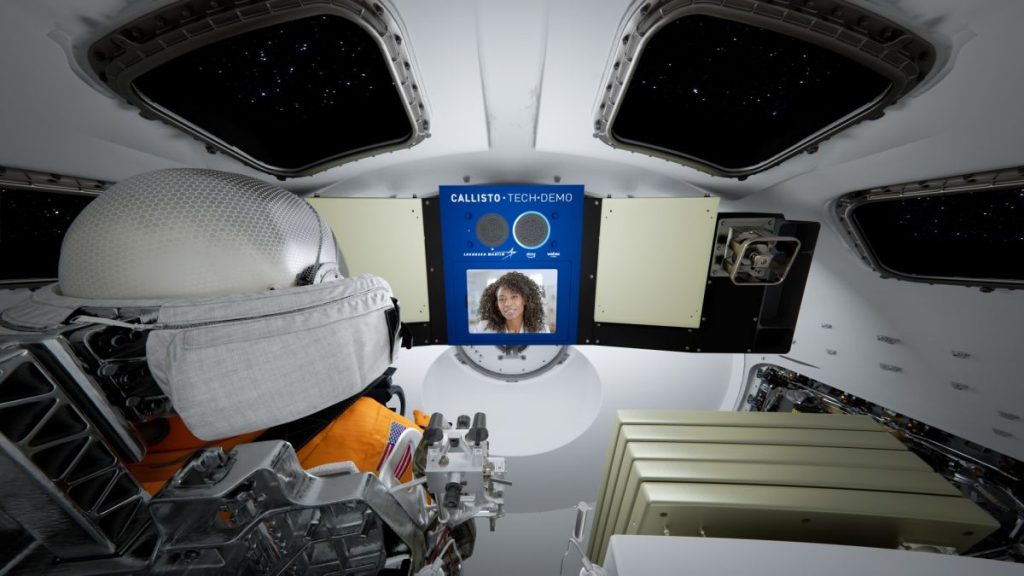NASA’s upcoming Artemis 1 mission, set to launch on Monday (Aug. 29), will carry a wide range of scientific payloads and spaceflight equipment designed to further our understanding of our neck of the cosmic woods and how to explore it.
That’s not all the massive Space Launch System rocket and Orion spacecraft will carry, however. Riding aboard Orion will be a revolutionary new technology demonstrator designed to change the way astronauts interact with their spacecraft: Callisto.
The Callisto system, developed by Lockheed Martin in partnership with Cisco and Amazon, leverages the same voice-activated capabilities offered by consumer virtual assistant technologies like Amazon’s Alexa or Apple’s Siri. Instead of alerting when packages have been delivered or turning lights on and off, Callisto is designed to one day provide real-time data, enhanced connectivity and mission-specific feedback for astronauts onboard future Orion missions.
Related: Artemis 1 cubesats: The 10 tiny satellites hitching a NASA ride to the moon
Callisto, named after a figure from Greek mythology who was a follower of Artemis, the Greek goddess of the moon and the hunt, will respond to natural language voice commands much in the same way that other Alexa-enabled products do, but focused specifically on the needs of a spaceflight crew and its mission controllers on the ground.
The Callisto device fits into a briefcase-like enclosure measuring 1.5 feet by 1 feet (45 by 30 centimeters) and approximately 5 inches (12.7 cm) in depth. Engineers at Lockheed Martin and Amazon had to ensure that the device could withstand the vibrations and extreme shocks of a rocket launch. In addition, Callisto’s electronics were hardened against the radiation environment of deep space.
A NASA statement (opens in new tab) published in January 2022 states that Callisto is “meant to show how commercial technology could assist future astronauts on deep space missions” and will demonstrate how “human-machine interface technology” can make spaceflight simpler, safer and more efficient for astronauts and ground crews alike.
“I can imagine a future where astronauts can access information on flight status and telemetry — such as spacecraft orientation, water supply levels or battery voltage status, through simple voice commands,” Howard Hu, deputy Orion program manager at NASA’s Johnson Space Center (JSC) in Houston, said in the statement. “Orion is already the most advanced spacecraft ever developed to carry astronauts to the moon, and voice activation technology could take it to the next level by enabling the interactive computer systems of science fiction spaceships to become a reality for the next generation of explorers.”
According to a Lockheed Martin statement (opens in new tab), Callisto will demonstrate “how voice technology, AI and portable tablet-based video conferencing can help improve efficiency and situational awareness for those on board the spacecraft.” In addition, the voice assistant will provide “access to real-time mission information and a virtual connection to people and information back on Earth.”
Built-in Cisco Webex video conferencing technology will enable mission controllers at JSC to interact with Callisto from the ground, “providing access to flight status and telemetry, and the ability to control connected devices onboard Orion,” according to a Cisco statement (opens in new tab).
Lockheed Martin says the goal for the Callisto tech demonstration is to “explore how these commercial technologies can support astronauts on future deep space missions to the moon and beyond.”
In a NASA Artemis technology demonstration and solar system science payloads teleconference (opens in new tab) held on Aug. 16, Rob Chambers, director of commercial civil space strategy at Lockheed Martin, said that the Callisto team drew inspiration from science fiction.
“We looked at what technologies are out there but also at a kind of common mission statement we saw with the companies [Cisco and Amazon],” Chambers said. “And I’ll be honest: We picked up the phone and called Amazon and it was one of those ‘Hey, what do you think about flying and Alexa on the other side of the moon,’ and I expected to get a very puzzled response. But instead they explained that one of the — and this is their story, but they share it a lot — one of the progenitors for Alexa, one of the bots that they had, if you will, was the voice computer from Starship Enterprise.
“As we started talking with them, and talked about some of their local here-on-Earth activities where they have to operate Alexa without the internet, we realized it was a really awesome test case for what they wanted to do,” Chambers continued. “So the response was so strong, and the technologies and the knowledge was, and our kind of commitment to the mission and conductivity was really powerful from the get go, [so] that we just never looked back.”
Unlike consumer Alexa-enabled devices that rely on an internet connection, Callisto will connect to mission controllers using NASA’s Deep Space Network and be equipped with a technology known as Local Voice Control, which “allows Alexa to process voice commands locally, rather than sending information to the cloud,” according to an Amazon statement (opens in new tab).
If current weather forecasts hold and all goes according to plan, NASA’s Artemis 1 mission will launch on Monday (Aug. 29), sending an uncrewed Orion spacecraft to lunar orbit and back, Callisto and all.
Follow Brett on Twitter at @bretttingley. Follow us on Twitter @Spacedotcom or on Facebook.

